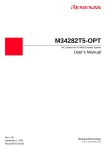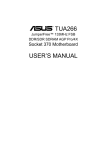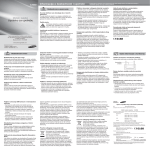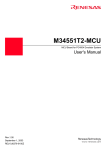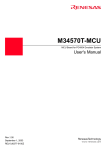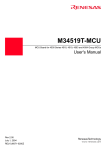Download Renesas MCU Board for PC4400 Emulator System M34282T5-OPT Technical information
Transcript
To our customers, Old Company Name in Catalogs and Other Documents On April 1st, 2010, NEC Electronics Corporation merged with Renesas Technology Corporation, and Renesas Electronics Corporation took over all the business of both companies. Therefore, although the old company name remains in this document, it is a valid Renesas Electronics document. We appreciate your understanding. Renesas Electronics website: http://www.renesas.com April 1st, 2010 Renesas Electronics Corporation Issued by: Renesas Electronics Corporation (http://www.renesas.com) Send any inquiries to http://www.renesas.com/inquiry. Notice 1. 2. 3. 4. 5. 6. 7. All information included in this document is current as of the date this document is issued. Such information, however, is subject to change without any prior notice. Before purchasing or using any Renesas Electronics products listed herein, please confirm the latest product information with a Renesas Electronics sales office. Also, please pay regular and careful attention to additional and different information to be disclosed by Renesas Electronics such as that disclosed through our website. Renesas Electronics does not assume any liability for infringement of patents, copyrights, or other intellectual property rights of third parties by or arising from the use of Renesas Electronics products or technical information described in this document. No license, express, implied or otherwise, is granted hereby under any patents, copyrights or other intellectual property rights of Renesas Electronics or others. You should not alter, modify, copy, or otherwise misappropriate any Renesas Electronics product, whether in whole or in part. Descriptions of circuits, software and other related information in this document are provided only to illustrate the operation of semiconductor products and application examples. You are fully responsible for the incorporation of these circuits, software, and information in the design of your equipment. Renesas Electronics assumes no responsibility for any losses incurred by you or third parties arising from the use of these circuits, software, or information. When exporting the products or technology described in this document, you should comply with the applicable export control laws and regulations and follow the procedures required by such laws and regulations. You should not use Renesas Electronics products or the technology described in this document for any purpose relating to military applications or use by the military, including but not limited to the development of weapons of mass destruction. Renesas Electronics products and technology may not be used for or incorporated into any products or systems whose manufacture, use, or sale is prohibited under any applicable domestic or foreign laws or regulations. Renesas Electronics has used reasonable care in preparing the information included in this document, but Renesas Electronics does not warrant that such information is error free. Renesas Electronics assumes no liability whatsoever for any damages incurred by you resulting from errors in or omissions from the information included herein. Renesas Electronics products are classified according to the following three quality grades: “Standard”, “High Quality”, and “Specific”. The recommended applications for each Renesas Electronics product depends on the product’s quality grade, as indicated below. You must check the quality grade of each Renesas Electronics product before using it in a particular application. You may not use any Renesas Electronics product for any application categorized as “Specific” without the prior written consent of Renesas Electronics. Further, you may not use any Renesas Electronics product for any application for which it is not intended without the prior written consent of Renesas Electronics. Renesas Electronics shall not be in any way liable for any damages or losses incurred by you or third parties arising from the use of any Renesas Electronics product for an application categorized as “Specific” or for which the product is not intended where you have failed to obtain the prior written consent of Renesas Electronics. The quality grade of each Renesas Electronics product is “Standard” unless otherwise expressly specified in a Renesas Electronics data sheets or data books, etc. “Standard”: 8. 9. 10. 11. 12. Computers; office equipment; communications equipment; test and measurement equipment; audio and visual equipment; home electronic appliances; machine tools; personal electronic equipment; and industrial robots. “High Quality”: Transportation equipment (automobiles, trains, ships, etc.); traffic control systems; anti-disaster systems; anticrime systems; safety equipment; and medical equipment not specifically designed for life support. “Specific”: Aircraft; aerospace equipment; submersible repeaters; nuclear reactor control systems; medical equipment or systems for life support (e.g. artificial life support devices or systems), surgical implantations, or healthcare intervention (e.g. excision, etc.), and any other applications or purposes that pose a direct threat to human life. You should use the Renesas Electronics products described in this document within the range specified by Renesas Electronics, especially with respect to the maximum rating, operating supply voltage range, movement power voltage range, heat radiation characteristics, installation and other product characteristics. Renesas Electronics shall have no liability for malfunctions or damages arising out of the use of Renesas Electronics products beyond such specified ranges. Although Renesas Electronics endeavors to improve the quality and reliability of its products, semiconductor products have specific characteristics such as the occurrence of failure at a certain rate and malfunctions under certain use conditions. Further, Renesas Electronics products are not subject to radiation resistance design. Please be sure to implement safety measures to guard them against the possibility of physical injury, and injury or damage caused by fire in the event of the failure of a Renesas Electronics product, such as safety design for hardware and software including but not limited to redundancy, fire control and malfunction prevention, appropriate treatment for aging degradation or any other appropriate measures. Because the evaluation of microcomputer software alone is very difficult, please evaluate the safety of the final products or system manufactured by you. Please contact a Renesas Electronics sales office for details as to environmental matters such as the environmental compatibility of each Renesas Electronics product. Please use Renesas Electronics products in compliance with all applicable laws and regulations that regulate the inclusion or use of controlled substances, including without limitation, the EU RoHS Directive. Renesas Electronics assumes no liability for damages or losses occurring as a result of your noncompliance with applicable laws and regulations. This document may not be reproduced or duplicated, in any form, in whole or in part, without prior written consent of Renesas Electronics. Please contact a Renesas Electronics sales office if you have any questions regarding the information contained in this document or Renesas Electronics products, or if you have any other inquiries. (Note 1) “Renesas Electronics” as used in this document means Renesas Electronics Corporation and also includes its majorityowned subsidiaries. (Note 2) “Renesas Electronics product(s)” means any product developed or manufactured by or for Renesas Electronics. User’s Manual M34282T5-OPT User’s Manual MCU Board for PC4400 Emulator System Rev.1.00 2003.09 * MS-DOS is a registered trademark of Microsoft Corporation. * IBM PC/AT is a registered trademark of International Business Machines Corporation. Keep safety first in your circuit designs! • Renesas Technology Corporation and Renesas Solutions Corporation put the maximum effort into making semiconductor products better and more reliable, but there is always the possibility that trouble may occur with them. Trouble with semiconductors may lead to personal injury, fire or property damage. Remember to give due consideration to safety when making your circuit designs, with appropriate measures such as (i) placement of substitutive, auxiliary circuits, (ii) use of nonflammable material or (iii) prevention against any malfunction or mishap. Notes regarding these materials • These materials are intended as a reference to assist our customers in the selection of the Renesas Technology product best suited to the customer's application; they do not convey any license under any intellectual property rights, or any other rights, belonging to Renesas Technology Corporation, Renesas Solutions Corporation or a third party. • Renesas Technology Corporation and Renesas Solutions Corporation assume no responsibility for any damage, or infringement of any third-party's rights, originating in the use of any product data, diagrams, charts, programs, algorithms, or circuit application examples contained in these materials. • All information contained in these materials, including product data, diagrams, charts, programs and algorithms represents information on products at the time of publication of these materials, and are subject to change by Renesas Technology Corporation and Renesas Solutions Corporation without notice due to product improvements or other reasons. It is therefore recommended that customers contact Renesas Technology Corporation, Renesas Solutions Corporation or an authorized Renesas Technology product distributor for the latest product information before purchasing a product listed herein. The information described here may contain technical inaccuracies or typographical errors. Renesas Technology Corporation and Renesas Solutions Corporation assume no responsibility for any damage, liability, or other loss rising from these inaccuracies or errors. Please also pay attention to information published by Renesas Technology Corporation and Renesas Solutions Corporation by various means, including the Renesas home page (http://www.renesas.com). • When using any or all of the information contained in these materials, including product data, diagrams, charts, programs, and algorithms, please be sure to evaluate all information as a total system before making a final decision on the applicability of the information and products. Renesas Technology Corporation and Renesas Solutions Corporation assume no responsibility for any damage, liability or other loss resulting from the information contained herein. • Renesas Technology semiconductors are not designed or manufactured for use in a device or system that is used under circumstances in which human life is potentially at stake. Please contact Renesas Technology Corporation, Renesas Solutions Corporation or an authorized Renesas Technology product distributor when considering the use of a product contained herein for any specific purposes, such as apparatus or systems for transportation, vehicular, medical, aerospace, nuclear, or undersea repeater use. • The prior written approval of Renesas Technology Corporation and Renesas Solutions Corporation is necessary to reprint or reproduce in whole or in part these materials. • If these products or technologies are subject to the Japanese export control restrictions, they must be exported under a license from the Japanese government and cannot be imported into a country other than the approved destination. Any diversion or reexport contrary to the export control laws and regulations of Japan and/or the country of destination is prohibited. • Please contact Renesas Technology Corporation or Renesas Solutions Corporation for further details on these materials or the products contained therein. Precautions to be taken when using this product • This product is a development supporting unit for use in your program development and evaluation stages. In mass-producing your program you have finished developing, be sure to make a judgment on your own risk that it can be put to practical use by performing integration test, evaluation, or some experiment else. • In no event shall Renesas Solutions Corporation be liable for any consequence arising from the use of this product. • Renesas Solutions Corporation strives to renovate or provide a workaround for product malfunction at some charge or without charge. However, this does not necessarily mean that Renesas Solutions Corporation guarantees the renovation or the provision under any circumstances. • This product has been developed by assuming its use for program development and evaluation in laboratories. Therefore, it does not fall under the application of Electrical Appliance and Material Safety Law and protection against electromagnetic interference when used in Japan. For inquiries about the contents of this document or product, fill in the text file the installer of the emulator debugger generates in the following directory and email to your local distributor. \SUPPORT\Product-name\SUPPORT.TXT Renesas Tools Homepage http://www.renesas.com/en/tools ( 2 / 38 ) Contents Preface ....................................................................................................................................4 1. Precautions for Safety ......................................................................................................... 5 1.1 Safety Symbols and Meanings ..............................................................................5 2. Handling Precautions .......................................................................................................... 9 2.1 Handling Precautions ............................................................................................ 9 3. Contents of M34282T5-OPT Package ............................................................................. 11 3.1 Package Components of M34282T5-OPT .......................................................... 11 3.2 Other Necessary Products ................................................................................... 11 4. M34282T5-OPT ............................................................................................................... 13 4.1 Outline ................................................................................................................. 13 4.2 Specifications ...................................................................................................... 14 4.3 Switches .............................................................................................................. 15 4.4 Check Pins ........................................................................................................... 17 4.5 Connectors ........................................................................................................... 17 4.6 Connecting MCU Board to Target System ......................................................... 20 4.7 LED ..................................................................................................................... 22 5. Precautions to Be Taken When Debugging ...................................................................... 23 5.1 Reset .................................................................................................................... 23 5.2 Capacity of Internal Memory (ROM, RAM) ...................................................... 23 5.3 Watchdog Timer .................................................................................................. 23 5.4 System Clock ...................................................................................................... 24 5.5 Real-time Capability of Timer ............................................................................ 24 5.6 Power-down Mode .............................................................................................. 24 5.7 Program Execution (G, GB) ................................................................................ 25 5.8 Pulldown Transistor Control ............................................................................... 27 5.9 Port I/O Timing ................................................................................................... 27 5.10 Port I/O Characteristics ..................................................................................... 28 5.11 External Trigger ................................................................................................ 29 5.12 Other Precautions .............................................................................................. 29 6. LED of PC4000E .............................................................................................................. 31 6.1 LED Indication at Emulator Startup ................................................................... 31 6.2 LED Indication during Emulator Operation ....................................................... 31 7. M34282T5-OPT Connection Circuit Diagram ................................................................. 33 8. External Dimensions of Emulator Probe .......................................................................... 35 8.1 20-pin Pin Header ............................................................................................... 35 Appendix A .......................................................................................................................... 36 ( 3 / 38 ) Preface This instruction manual describes the specifications of the M34282T5-OPT emulator board for Renesas 4282 Group of 4-bit CMOS single-chip MCUs. The M34282T5-OPT is the MCU board for the PC4400 emulator system connected to the PC4000E emulator main unit and used with a control board and a function expansion board. To use the product properly Precautions for Safety: • Both in this User's Manual and on the product itself, several icons are used to insure proper handling of this product and also to prevent injuries to you or other persons, or damage to your properties. • The icons' graphic images and meanings are given in "Chapter 1. Precautions for Safety". Be sure to read this chapter before using the product. ( 4 / 38 ) 1. Precautions for Safety Both in this instruction manual and on the product, several icons are used to insure proper handling of this product and also to prevent injuries to you or other persons, or damage to your properties. This chapter describes precautions which should be taken in order to use this product safely and properly. Be sure to read this chapter before using this product. 1.1 Safety Symbols and Meanings WARNING If the requirements shown in the "WARNING" sentences are ignored, the equipment may cause serious personal injury or death. CAUTION If the requirements shown in the "CAUTION" sentences are ignored, the equipment may malfunction. IMPORTANT It means important information on using this product. In addition to the three above, the following are also used as appropriate. means WARNING or CAUTION. Example: CAUTION AGAINST AN ELECTRIC SHOCK means PROHIBITION. Example: DISASSEMBLY PROHIBITED means A FORCIBLE ACTION. Example: UNPLUG THE POWER CABLE FROM THE RECEPTACLE. The following pages describe the symbols "WARNING", "CAUTION", and "IMPORTANT". ( 5 / 38 ) WARNING Warning for Installation: • Do not set this product in water or areas of high humidity. Spilling water or some other liquid into the main unit can cause an unrepairable damage. Warning for Use Environment: • This equipment is to be used in an environment with a maximum ambient temperature of 35°C. Care should be taken that this temperature is not exceeded. CAUTION Cautions to Be Taken for This Product: • Do not disassemble or modify this product. Disassembling or modifying this product can cause damage. • Use caution when handling the main unit. Be careful not to apply a mechanical shock. • Do not pull the pod probe by the cables (40-wire half-pitch cable or 20-wire normal-pitch cable). • Do not use inch-size screws for this equipment. The screws used in this equipment are all ISO (meter-size) type screws. When replacing screws, use same type screws as equipped before. ( 6 / 38 ) IMPORTANT Notes on Difference between Actual MCU and Emulator: • Emulator operation differs from that of a mask MCU as listed below. For details refer to "5. Precautions to Be Taken When Debugging". (1) Reset condition (2) Initial values of internal resource data at power-on (3) Internal memory (ROM and RAM) capacities, etc. (4) System clock (5) Operation of the watchdog timer function (6) Real-time capability of timer (7) Operation in power-down mode (8) Pulldown transistor control (9) Port I/O timing and characteristics (10) Low-power detection function • Therefore, always be sure to evaluate your system with an evaluation MCU (OTP version). Also, be sure to perform board-mounted evaluation with ES (Engineering Sample) version MCU to make final confirmation of device operation before starting mask production. Note on Target System: • The operation voltage of the M34282T5-OPT is +3.0 V. Therefore the target's supply voltage should be in the range of +3.0 V ±10%. Note on System Clock: • The maximum operating frequency of the M34282T5-OPT is 4.0 MHz (STCK = f(XIN)/8) or 500 kHz (STCK = f(XIN)). When the instruction clock is set to f(XIN), set the system clock frequency of the M34282T5-OPT to 500 kHz or less. Notes on Connecting Target System: • When connecting the target system, be sure to shut OFF the power of the emulator and target system. • When connecting the emulator probe, be careful of its orientation. • When connecting the emulator probe, be careful of a warp of the cable. The warp may cause a break in the wire. ( 7 / 38 ) MEMO ( 8 / 38 ) 2. Handling Precautions 2.1 Handling Precautions When using the M34282T5-OPT board, pay attention to the following: (1) About an emulator system To configure the emulator system with the M34282T5-OPT, the following products are required. a. Emulator main unit (PC4000E) This is an universal emulator main unit for the 720 Series. b. Emulator card cage (PC4400) This is an emulator card cage to contain the emulator main unit, control board, function extension board and M34282T5-OPT board. c. Control board (PCA4400A) This is an emulator control board for the PC4400 system. The PCA4400A allows the user to control program execution and reference/change contents of memory, as well as control break functions etc. of the PC4400 system. d. Function extension board (PCA4400R) This is used by inserting into the PC4400, and allows the user to control real-time trace, program execution time measurement, coverage analysis, etc. of the PC4400 system. e. Power supply As the PC4400 emulator system does not contain the power supply, the M34282T5-OPT should be powered separately by an external power supply such as a switching power supply or a stabilized power supply. For an external power supply, chose the one which suit to the specifications below. - For +5 V: - For +12 V: 3.0 A or over 0.1 A or over f. Emulator debugger (RTT72) This consists of assembler and emulator debugger for the 720 Series. The RTT72 is used with data files for 4282 Group. For details, refer to the user's manual of RTT72. (2) About the MCU board installation Before installing (and removing) the MCU board, always be sure to power off the PC4000E emulator main unit and unplug its power cord from the outlet. (3) Registers that can be operated from the RTT72 Table 2.1 lists the registers that can be operated from the RTT72. The "Yes" means that the register can be operated; "No" means that the register can not be operated. Table 2.1 Registers that can be operated from RTT72 Register Reference Modify Register Reference Modify PC Yes Yes V1 No Yes CY Yes Yes V2 No Yes A Yes Yes LO No Yes B Yes Yes PU0 No Yes D No Yes PU1 No Yes E Yes Yes X Yes Yes Y Yes Yes *: "0" is always indicated when referencing the register Z. ( 9 / 38 ) MEMO ( 10 / 38 ) 3. Contents of M34282T5-OPT Package 3.1 Package Components of M34282T5-OPT Table 3.1 shows the package components of the M34282T5-OPT. When unpacking your package, check to see that all of these components are included. Table 3.1 Contents of M34282T5-OPT Item Quantity M34282T5-OPT 1 40-wire half-pitch cable (40 cm) 1 20-wire normal-pitch cable (10 cm) 1 2-wire cable for external trigger signal (50 cm) 1 PCA4029 pitch converter board 1 Oscillator board OSC-2 (500 kHz) 1 Oscillator board OSC-2 (only J1 connector mounted) 1 M34282T5-OPT Instruction manual (this manual) 1 M34282T5-OPT Instruction Manual (Japanese) 1 *1 The M34282T5-OPT has a 4MHz oscillator circuit board OSC-2 that is incorporated when shipped from the factory. In addition, an oscillator circuit board OSC-2 for 500 kHz and an oscillator circuit board OSC-2 on which only J1 connector mounted are included. *2 Keep the packaging carton and cushion material of the M34282T5-OPT to transport it for repair or for other purposes in the future. *3 If you find any item missing or faulty, or any suggestion, contact your local distributor. 3.2 Other Necessary Products To bring forward program development on the 4282 Group of 4-bit MCUs, the products listed in Table 3.2 are necessary in addition to those contained in the package above. Get them separately to be ready when necessary. Table 3.2 Products required for program development on the 4282 Group MCUs PC4000E (emulator main unit) PC4400 (emulator card cage) Emulator system PCA4400A (control board) PCA4400R (function expansion board) Emulator debugger RTT72 Serial programmer* MSP-II EFP-I (PROM & FLASH programmer main unit) PROM & FLASH programmer* EF1SRP-01U (unit for serial writing) Cable for connecting the target (3-line type) MS4238-20F (for 20P2N-A package) PROM programming adapters* MS4280-20G (for 20P2E/F-A package) * The serial programmers and PROM programming adapters in Table 3.2 are products of Suisei Electronics System Co., Ltd. For inquiries about these products, contact Suisei Electronics System Co., Ltd. Suisei Electronics System Co., Ltd. Tsurumi 6-5-24, Tsurumi-ku, Osaka 538-0053, JAPAN Tel: +81-6-913-4531 Fax: +81-6-913-4534 URL: http://www.suisei.co.jp/index_e.htm ( 11 / 38 ) MEMO ( 12 / 38 ) 4. M34282T5-OPT 4.1 Outline By using with the PC4400 emulator for the 720 Series, the M34282T5-OPT can make up an emulator system which can be operated by a personal computer. Figure 4.1 shows the emulator system configuration. Figure 4.1 Emulator system configuration * For how to connect to the target system, refer to "4.6 Connecting MCU Board to Target System" (page 20). ( 13 / 38 ) 4.2 Specifications Table 4.1 lists specifications of the M34282T5-OPT. Table 4.1 Specifications of M34282T5-OPT Applicable MCU 4282 Group MCUs Evaluation MCU M34282E2GP (on board) System clock 4 MHz (using OSC-2 [4 MHz])* Maximum operating clock frequency 4.0 MHz (STCK=f(XIN)/8) VDD = 3 V 500 kHz (STCK=f(XIN)) Target system supply voltage 3V Power supply Supplied from the PC4400 (+5 V, +12 V) Port Output type Direction D0 to D3 Output D4 to D7 Port emulation G0 to G3 Device used P-channel open drain Input: 74HC541 Output: TD62787 Input/output E0 E1 E2 - Input Input: 74HC4066 Output: 74HC4066 CARR CMOS Output Output: 74VHC08 Board dimensions 233 mm (L) x 120 mm (W) x 26.0 mm (H) Operating temperature 5 to 35°C (no dew) Product configuration M34282T5-OPT 40-wire half-pitch cable 20-wire normal-pitch cable External trigger cable PCA4029 OSC-2 x2 (for 500 kHz, for changing the frequency) * The M34282T5-OPT has a 4MHz oscillator circuit board OSC-2 that is incorporated when shipped from the factory. In addition, an oscillator circuit board OSC-2 for 500 kHz and an oscillator circuit board OSC-2 on which only J1 connector mounted are included. ( 14 / 38 ) 4.3 Switches Figure 4.2 shows the locations of switches of the M34282T5-OPT and Tables 4.2 and 4.3 list the functions of each switch and its factory-settings. Figure 4.2 Switch locations Table 4.2 Functions of switches (1/2) Switch Switch setting Description VDD OFF ON OFF Does not output the V DD from the M34282T5-OPT to the target system. OFF Outputs the VDD from the M34282T5OPT to the target system. Factory-setting SW1 VDD ON ON OFF CPUSE0 L H L SW2 CPUEL0 H H Sets the ROM type of MCU. For M1: "L" For M2: "H" H L SW3 H CPUSEL1 H L This switch is not used. Do not change the CPUSEL1 setting. H OFF The pulldown resistors of ports G0 and G1 are OFF. OFF ON SW4 OFF The pulldown resistors of ports G0 and G1 are ON. ON ON ( 15 / 38 ) OFF Table 4.3 Functions of switches (2/2) Switch Switch setting Description Factory-setting OFF The pulldown resistors of ports G2 and G3 are OFF. OFF ON SW5 OFF The pulldown resistors of ports G2 and G3 are ON. ON OFF ON OFF The pulldown resistor of port D4 is OFF. OFF ON SW6 OFF The pulldown resistor of port D4 is ON. ON OFF ON OFF The pulldown resistor of port D5 is OFF. OFF ON SW7 OFF The pulldown resistor of port D5 is ON. ON OFF ON OFF The pulldown resistor of port D6 is OFF. OFF ON SW8 OFF The pulldown resistor of port D6 is ON. ON OFF ON OFF The pulldown resistor of port D7 is OFF. OFF ON SW9 OFF The pulldown resistor of port D7 is ON. ON OFF ON OFF The pulldown resistor of port E0 is OFF. OFF ON SW10 OFF The pulldown resistor of port E0 is ON. ON ON ( 16 / 38 ) OFF 4.4 Check Pins The M34282T5-OPT has the check pins listed in Table 4.4. Table 4.4 Check pins Pin Description TP1 VDD Outputs power voltage +3 V to the evaluation MCU. TP2 XIN Outputs system clock input to the evaluation MCU. TP4 WRST TP5 GND Outputs "H" level when executing WRST instruction. By observing pulse width, it is possible to confirm the initializing cycle of the watchdog timer. GND 4.5 Connectors Table 4.5 lists the functions of connectors of the M34282T5-OPT. Figure 4.3 shows the connector locations. Table 4.5 Connector list Connector Description J1 Connects the evaluation MCU bus. J2 Connects the monitor CPU bus. J3 Connects the target system (40-pin). J4 Connects external trigger signal (2-pin). J5 Connects the oscillator board (4-pin). Figure 4.3 Connector locations ( 17 / 38 ) (1) Connector J3 Table 4.6 lists the pin assignments of 40-wire half-pitch connector (J3) for connecting the PCA4029. And Figure 4.4 shows the J3 connector pin layout. Table 4.6 40-wire half-pitch connector (J3) for connecting PCA4029 Line A Line B I/O Line C I/O Line D Pin No. Signal Pin No. Signal Pin No. Signal I/O Pin No. Signal 1 GND 1 GND 1 VSS O 1 VDD I/O O 2 GND 2 GND 2 E2 I 2 CARR O 3 GND 3 GND 3 E1 I/O 3 D0 O 4 GND 4 GND 4 XIN - 4 D1 O 5 GND 5 GND 5 XOUT - 5 D2 O 6 GND 6 GND 6 E0 I/O 6 D3 O 7 GND 7 GND 7 G0 I/O 7 D4 I/O 8 GND 8 GND 8 G1 I/O 8 D5 I/O 9 GND 9 GND 9 G2 I/O 9 D6 I/O 10 GND 10 GND 10 G3 I/O 10 D7 I/O * "I" in the I/O column denotes "Input"; "O" denotes "Output"; "I/O" denotes "Input/output"; "-" denotes "Not connected". Figure 4.4 J3 connector pin layout (2) J4 connector For the J4 connector, use the 2-wire external trigger signal cable included with your M34282T5OPT board. Connect the black clip to GND and the white clip to the external trigger signal input. An external trigger signal is used to cause an external trigger break or set an external triggerbased trace point. Table 4.7 lists the pin assignments of the J4 connector. Table 4.7 Pin assignments of J4 connector Pin No. Signal Description 1 TRIG External trigger signal input 2 GND GND ( 18 / 38 ) (3) J5 connector The J5 connector is a connector used to connect an oscillator board (OSC-2). Table 4.8 lists the pin assignments of the J5 connector. Figure 4.5 shows the pin layout of the J5 connector. For the 4.0MHz operation with the OSC-2 oscillator board, see Figure 4.6. Table 4.8 Pin assignments of J5 connector Pin No. Signal Description 1 VCC Power supply 2 GND GND 3 CLK Clock input 4 GND GND Figure 4.5 Pin layout of J5 connector Figure 4.6 Circuit diagram of OSC-2 (4.0 MHz) ( 19 / 38 ) 4.6 Connecting MCU Board to Target System Figure 4.7 shows the connection to the target system using the 20-wire normal-pitch cable. Connect the M34282T5-OPT with the IC socket for 2.54-mm-pitch 20-pin DIP (e.g. IC26-2003-GS4: made by Yamaichi Electronics Co., Ltd.) on the target system using the included 20-wire normal-pitch flat cable. However, the M34282T5-OPT cannot be connected to the foot pattern of the MCU package (20P2NA or 20P2E/F-A). For this connection, you need three accessory parts listed below: (1) 40-wire half-pitch cable (40 cm) (2) Pitch converter board PCA4029 (3) 20-wire normal-pitch cable (10 cm) Table 4.9 lists the connector signal assignments of the 20-wire normal-pitch cable. Figure 4.8 shows the pin layout of the 20-wire normal-pitch cable. Figure 4.7 Connecting target system ( 20 / 38 ) Table 4.9 20-wire normal-pitch cable pin assignments 20-wire normal-pitch cable 1 VSS 20 VDD 2 E2 19 CARR 3 E1 18 D0 4 XIN (not connected) 17 D1 5 XOUT (not connected) 16 D2 6 E0 15 D3 7 G0 14 D4 8 G1 13 D5 9 G2 12 D6 10 G3 11 D7 *1 The VDD does not input the power supply voltage from the target system, but outputs from the power circuit on the M34282T5-OPT to the target system. The VDD can output by setting the switch SW1. For how to set the switches, refer to "4.3 Switches" (page 15). *2 XIN is input from the oscillator circuit board OSC-2 and cannot be input from the oscillator circuit board on the target system. When changing the system clock frequency, change the frequency of the oscillator circuit board OSC-2 to use. Figure 4.8 Pin layout of 20-wire normal-pitch cable ( 21 / 38 ) An evaluation MCU on the M34282T5-OPT and the target system are connected as shown below. (1) Pin connected directly to the target system (1 type, 1 line) • VSS (2) Pins connected to the target system via emulation circuits etc. (5 types, 17 lines) • G0 to G3 • D0 to D7 • E0 to E2 • CARR • VDD (3) Pins not connected to the target system (2 types, 2 lines) • XIN • XOUT * With the M34282T5-OPT, XIN and XOUT pins are not connected to the target system. Therefore, when changing the system clock frequency, change the frequency of the oscillator circuit board OSC-2. 4.7 LED Figure 4.9 shows the LED layout of M34282T5-OPT. The LED lights in green when the power is supplied to the MCU board. Figure 4.9 Layout of LED ( 22 / 38 ) 5. Precautions to Be Taken When Debugging 5.1 Reset The M34282T5-OPT can be reset by the reset command of emulator debugger RTT72, but cannot emulate device operation at power-on reset. Use an evaluation MCU (OTP version) to verify the operation associated with power-on reset. 5.2 Capacity of Internal Memory (ROM, RAM) The M34282T5-OPT is equipped with the M34282E2GP as an evaluation MCU. The RAM and ROM areas that can be referenced by emulator debugger RTT72 are specified by switches SW2 and SW3 as listed in Table 5.1. Table 5.1 Memory areas that can be referenced by emulator debugger RTT72 Switch setting SW3 SW2 RAM area ROM area "L" 00h - 0Bh 10h - 1Bh 20h - 2Bh 30h - 3Bh (4 bits x 48 words) 000h - 3FFh (9 bits x 1024 words) "H" 00h - 3Fh (4 bits x 64 words) 000h - 7FFh (9 bits x 2048 words) "H" * Addresses in the RAM area are shown as described below according to the data pointer registers X and Y. Example: RAM address XXh Y (Y = 0 to B, or Y = 0 to F) X (X = 0 to 3) 5.3 Watchdog Timer With the M34282T5-OPT, the watchdog timer cannot be operated. Therefore use an evaluation MCU (OTP version) to verify the operation associated with the watchdog timer function. And with the M34282T5-OPT, when executing WRST instruction, the check pin TP4 outputs "H" level (see Figure 5.1), so you can check the initializing cycle of the watchdog timer by monitoring the pulse width frequency of TP4. System clock XIN WRST Figure 5.1 Output waveform of check pin TP4 ( 23 / 38 ) 5.4 System Clock Depending on how the instruction clock is set, use the M34282T5-OPT in the range of frequencies listed in table 5.2. When the instruction clock is set to STCK = f(XIN) and the system clock frequency is over 500 kHz, the emulator may not work properly. Table 5.2 Operating frequencies of the M34282T5-OPT Voltage Instruction clock Frequency STCK = f(XIN)/8 4.0 MHz or less STCK = f(XIN) 500 kHz or less 3V * To change the system clock frequency, change the clock frequency of the oscillator circuit board OSC-2. For details about the oscillation circuit constant, consult your oscillator manufacturer. 5.5 Real-time Capability of Timer As the evaluation MCU is active even when program execution is stopped or when a command is executed, its timer values are modified. Examples: (1) When single-stepping instructions (2) After program execution stopped 5.6 Power-down Mode Although the M34282T5-OPT can execute a program using the POF instruction, there are precautions and restrictions listed in Table 5.3. Table 5.3 Precautions for power-down mode. Description 1 Although SAFE and ERROR LEDs of the PC4000E light up in the power-down mode, it is not an error condition. 2 Do not use the POF instruction when single-stepping a program. The POF instruction can not be executed correctly when stepped through. 3 No debug command of emulator debugger RTT72 can be executed. In the power-down mode, execute the debug command after resuming by the key-on wakeup function. 4 The real-time trace result of the area including the POF instruction cannot be displayed normally. ( 24 / 38 ) 5.7 Program Execution (G, GB) The PC4400 and the M34282T5-OPT's hardware are subject to the following restrictions with respect to the operation of the program execution commands (G and GB). (1) Continuous description of instructions Hardware break points set in a continuous description of instructions following one after another do not cause a break to occur in the continuous description of instructions. A break occurs only after fetching the address where the continuous description of instructions is discontinued. (See Program example 5.1) However, a break does occur even in a continuous description of instructions when an external trigger break or forced break is encountered. For execution to be resumed in this case, you need to make sure that the execution start address is next to the continuous description of instructions. (See Program example 5.2) Program example 5.1 POINT: POINT+2: LA LA LA XAM 0 1 2 3 ; Continuous description of instructions If a break is set at POINT, execution is halted immediately before the XAM instruction at address POINT+2. Program example 5.2 POINT: POINT+1: POINT+2: LA LA LA XAM 0 1 2 3 ; Continuous description of instructions If a forced or external trigger break is applied at POINT, execution is halted at POINT+1. When resuming program execution after the break, make sure that the start address is at POINT+2, an address immediately after the continuous description of instructions is discontinued. ( 25 / 38 ) (2) Skip instructions (e.g. SNZP, INY, DEY, SZB, SEAM, SZC and RTS) In cases when a skip instruction skips the next instruction, a break point set in the skipped instruction does not cause execution to halt. (See Program examples 5.3 and 5.4) Program example 5.3 POINT: POINT_A: LXY SZD B TAM • • 0,0 jmp_adr 0 ; Skip when D(0) = 0 If a break point is set at POINT, D(0) = 0: Execution is halted immediately before the instruction at POINT. D(0) = 1: Execution is NOT halted because the instruction at POINT is skipped. To halt execution immediately after a skip instruction, set break points at POINT and POINT_A. Program example 5.4 POINT: RC INY TABP LA 0 • • ; Skip when (Y) = 0 If a break with pass count is set at address POINT, the count is taken and execution is halted only when the instruction at address POINT is executed. ( 26 / 38 ) 5.8 Pulldown Transistor Control Since ports D4 to D7, E0 and G0 to G3 contain emulation circuits, you can not control the pulldown resistors using the pulldown control register. If you want to use the internal pulldown resistors, turn on switches SW4 to SW10 when occasion demands. With the M34282T5-OPT, the port's resistance value of the pulldown resistor is 150 kΩ. When changing the resistance value of the pulldown resistor, replace RA1 (ports E0, G3 to G0) and RA2 (ports G7 to G4) on the M34282T5-OPT. For the position of the pulldown resistor, see Figure 4.3. 5.9 Port I/O Timing (1) Port input timing Port input timings are the same as with the actual MCUs. (2) Port output timing When using the M34282T5-OPT, output timings are different from those of the actual MCUs for the ports D0 to D7, E0 and G0 to G3 that are configured with port emulation circuits. With the actual MCUs, changes occur at the beginning of the T4 state of an output instruction. With the M34282T5-OPT, changes occur at the beginning of the T2 state of the next output instruction. Figure 5.2 shows the port timings of the actual MCUs and M34282T5-OPT. Port output timings of ports E1, E2 and CARR are the same as with the actual MCUs. Output Instruction Instruction clock STCK Ports D, E and G output timing of actual MCU Port D output timing of M34282T5-OPT Port E output timing of M34282T5-OPT Port G output timing of M34282T5-OPT Figure 5.2 Ports D, E and G output timings ( 27 / 38 ) Next output Instruction 5.10 Port I/O Characteristics With the M34282T5-OPT, port I/O characteristics are different from actual MCUs because there is an emulation circuit in ports E0, G0 to G3 and D0 to D7. Table 5.4 lists port I/O characteristics of the M34282T5-OPT. Table 5.4 Emulation port I/O characteristics Port Device Item VIH Input 74HC541 VIL E0 Output TD62787 - VCC = 4.5 V 3.15 V - VCC = 2.0 V - 0.5 V - VCE(sat) - - VCC = 2.0 V 1.5 V VCC = 4.5 V 3.15 V - VCC = 2.0 V - 0.5 V VCC = 4.5 V - ICEX - - VCE(sat) - - VCC = 2.0 V 1.5 V VCC = 4.5 V 3.15 V - VCC = 2.0 V - 0.5 V VCC = 4.5 V - 1.35 V ICEX - - VCE(sat) - - VCC = 2.0 V 1.5 V - IOH = -50 µA VCC = 4.5 V 3.15 V - IOH = -8 mA VCC = 2.0 V - 0.1 V IOL = 50 µA VCC = 4.5 V - 0.44 V IOL = 8 mA 1.35 V -100 µA VOUT = -50 V -1.8 V VIN = VIL, IOUT = -100 mA -2.0 V VIH Input 74HC541 VIL D4 to D7 Output TD62787 VOH CARR Output 74VHC08 VOL ( 28 / 38 ) VIN = VIL, IOUT = -350 mA - 1.35 V -100 µA VOUT = -50 V -1.8 V VIN = VIL, IOUT = -100 mA -2.0 V D0 to D3 Remarks - VIL Output TD62787 Max. VCC = 4.5 V 74HC541 G0 to G3 Min. 1.5 V ICEX VIH Input Voltage VCC = 2.0 V VIN = VIL, IOUT = -350 mA - -100 µA VOUT = -50 V -1.8 V VIN = VIL, IOUT = -100 mA -2.0 V VIN = VIL, IOUT = -350 mA 5.11 External Trigger (1) External trigger signal input timing The latch timing of the external trigger signal is shown in Figure 5.3. Output Instruction Next output Instruction Instruction clock STCK External trigger signal Figure 5.3 Latch timing of external trigger signal (2) External trigger signal input characteristics Trigger breaks work according to the condition (leading edge/trailing edge) of signals input from the external trigger cable. The external trigger signals of the trace points and the external trigger signals of the break points use the same signals. The input characteristics of the external trigger signals are shown in Table 5.5 below. See the table before using external trigger signals. Table 5.5 External trigger signal input characteristics Item Symbol H-level threshold voltage VIH L-level threshold voltage VIL Voltage Minimum Maximum VCC = 2.0 V 1.5 V - VCC = 4.5 V 3.15 V - VCC = 2.0 V - 0.5 V VCC = 4.5 V - 1.35 V 5.12 Other Precautions With the M34282T5-OPT, the system which uses the function below cannot be emulated. Therefore, always be sure to evaluate your system with an evaluation MCU (OTP version). • Low-voltage detection function ( 29 / 38 ) MEMO ( 30 / 38 ) 6. LED of PC4000E 6.1 LED Indication at Emulator Startup The emulator checks the PC4400 system immediately after startup. During system check the PC4000E's SAFE LED flashes and the ERROR LED stays on steady. If the SAFE LED does not flash, it means that the system check program is not operating. In such a case, check whether the PC4000E, PC4400 card cage and each circuit board are fitted correctly. When the system check is completed, the emulator status is indicated by the LEDs on the PC4000E. Table 6.1 shows the LED indications at startup of PC4400. Table 6.1 LED indication at emulator startup LED display Condition of PC4000E SAFE ERROR Turned ON Turned OFF Flash alternately The emulator has started up properly. Following may be considered: • Some board in the PC4400 main unit slot is not fitted in correctly. Check whether each board is fitted correctly. • An error is detected by the PC4400's system check. The PC4400 system may be faulty. Contact your local distributor for repair. 6.2 LED Indication during Emulator Operation It is possible to check the emulator status during operation by its LED indicators. Table 6.2 shows the LED indications during emulator operation. Table 6.2 LED indications during emulator operation LED display Condition of PC4000E SAFE ERROR Turned ON Turned OFF The emulator is ready to execute debug commands of emulator debugger RTT72. Turned ON The evaluation MCU is in the power-down mode or the emulator system has been reset. In this case, no debug command of emulator debugger RTT72 can be executed. In the power-down mode, execute the debug command after resuming by the key-on wakeup function. Turned ON ( 31 / 38 ) MEMO ( 32 / 38 ) 7. M34282T5-OPT Connection Circuit Diagram Figure 7.1 shows the M34282T5-OPT connection circuit diagram. This circuit diagram depicts the M34282T5-OPT connection centering on circuits connected to the target system. Emulator control blocks and other similar circuits that are not connected to the target system are omitted. Figure 7.1 M34282T5-OPT connection circuit diagram ( 33 / 38 ) MEMO ( 34 / 38 ) 8. External Dimensions of Emulator Probe 8.1 20-pin Pin Header Figure 8.1 shows the external dimensions of the emulator probe 2.54-mm-pitch 20-pin pin header of the M34282T5-OPT. Figure 8.1 External dimensions of 20-pin pin header ( 35 / 38 ) Appendix A. How to Request for Repair If your product is found faulty, follow the procedure below to send your product for repair. Customer Fill in the Repair Request Sheet included with this product, then send it along with this product for repair to your local distributor. Make sure that information in the Repair Request Sheet is written in as much detail as possible to facilitate repair. Distributor After checking the contents of fault, the distributor should please send the faulty product along with the Repair Request Sheet to Renesas Solutions Corp. Renesas Solutions When the faulty product is repaired, it will be returned to the customer at the earliest convenience. CAUTION Note on Transporting the Product: • When sending your product for repair, use the packing box and cushion material supplied with this product when delivered to you and specify handling caution for it to be handled as precision equipment. If packing of your product is not complete, it may be damaged during transportation. When you pack your product in a bag, make sure to use conductive polyvinyl supplied with this product (usually a blue bag). When you use other bags, they may cause a trouble on your product because of static electricity. ( 36 / 38 ) M34282T5-OPT User's Manual Rev.1.00 September 1, 2003 REJ10J0272-0100Z COPYRIGHT ©2003 RENESAS TECHNOLOGY CORPORATION AND RENESAS SOLUTIONS CORPORATION ALL RIGHTS RESERVED M34282T5-OPT User’s Manual 1753, Shimonumabe, Nakahara-ku, Kawasaki-shi, Kanagawa 211-8668 Japan REJ10J0272-0100Z








































